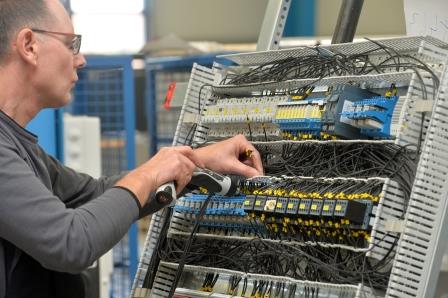Intelligent switchboards from Saxony-Anhalt

FEAG Sangerhausen GmbH focuses on the digitalisation of switchboard systems
Anyone who quickly calls the ENERGOLINE products from the company from Saxony-Anhalt control cabinets at first glance is not completely wrong. However, the second look reveals the individual features that mark FEAG Sangerhausen out as a global player: the flexibility in design and production, the development of newer and newer technologies and the integration of the most modern digital possibilities.
The list of properties in which switchboard systems of FEAG are used to produce, transmit and distribute electrical energy is impressively long and international: in paper factories and power plants of Africa, South America and Australia, in hotel complexes of the Middle East, at a steel works in Asia, at the seat of government in Moscow and at a refinery in central Germany.
Flexibility in every regard
Where is this success rooted? “The decisive thing is our flexibility,” says Koschmieder, outlining his company’s basic principle. “We do not deliver standard goods; rather, we develop and build only customised solutions, precisely according to the needs of our customers. This begins with the outer design of the switchboards, that is, with shape and colour, which generally depend on available conditions. In the past, we have manufactured systems that were 22 metres long.” However, the range of FEAG’s services is significantly more extensive. The processes begin with consulting and planning. Manufacturing comprises all steps from processing the plates or copper profiles, to assembling and testing the systems, to delivery. The technical areas of responsibility extend to switchboards for low voltage and medium voltage, protection and control technology, container solutions and service.
However, the questions that the engineers and technicians of FEAG-ENERGOLINE are currently occupying themselves with mostly go beyond flexibility – which has long been a matter of course – and are: How can the opportunities of digitalisation in switchboard systems be used more effectively than up to now? What more than mere power distribution can these systems be “taught”? Possibly the autonomous transmission of information about wear process within the system or about changes in the network? How could the service-orientated switchbox that “thinks for itself” be trained? The FEAG developers have found partners in answering these questions in medium-sized cooperation partners, institutes, universities and universities of applied sciences of Saxony-Anhalt. Customers of the company also collaborate on specifying the tasks.
Innovative 'crawler' module as data logger, gateway, sensor module and visualization tool
Koschmieder is already able to precisely name the potencies of such a digital control cabinet, which is being developed within the framework of the "Energoline.Digital" digitization concept: First, digital documentation should become possible where, for example, the person responsible can read data of the switchboard with their mobile phone. Second, the data would have to be connected to existing measurement and alarm management. And third, it is desirable to use the long-term-stored data for an analysis system, in order, for example, to be able to make statements regarding changes to the energy quality.
First of all, the concept contains intelligent electronic documentation that immediately provides all information, including plans and forms, to anyone working with the system. A further benefit is the monitoring of operating states via sensor data. The key points are displayed to the plant operator on his tablet or smartphone. A digital alarm management system could be based on this - the third advantage.
The Stored algorithms trigger the independent transmission of information about wear processes within the plant or about changes in the network. In this way, a timely service can prevent system failures. And fourthly, it is possible to use the data stored over a long period of time for an analysis system. This can then, for example, make statements about changes in energy quality and use operating data to optimize the system configuration or to save energy.
“Although such a thing is possible today, it is still very complex,” says Koschmieder regarding the state of affairs. “Wide use could become effective only through practicable plug-and-play components. We are working on these. Our central innovation here is the ‘Crawler’. It is a multi-functional platform and manufacturer-independent component and functions as a data logger, a gateway, a sensor component and a visualisation tool. We can use it in a wide variety of contexts and cope with the interface problems that arise. Energoline.Digital' should develop even more into a modular solution."
Constant growth
In summer 2018, the company at the edge of Sangerhausen celebrated its twenty-year anniversary. It was not by chance that the theme of the event was digitalisation in electrical engineering, the most important future task at present, as Managing Director Heiko Koschmieder explains. A look at the timeline: In 1990, Siemens acquired the traditional site of the power plant. In 1996, FEAG (Fertigungscenter für Elektrische Anlagen) was founded as a complete subsidiary of Siemens. Since 1998, FEAG has been family-owned and has operated as a mid-sized company. The products are marketed under the brand name ENERGOLINE. The 40 employees at that time have now become about 200, above all engineers and technicians, construction mechanics and electrical engineers for operating technology. Active work with young talent at schools, universities and abroad helps to cover the need for specialists. To meet the growing demand on the market, new production halls were repeatedly built – currently encompassing 12,000 square metres of production space – as well as additional office buildings.
The delivery of 70 low-voltage fields to the natural gas condenser station being built in Radeland, Brandenburg, one of the largest and most modern plants in Western Europe, the renovation of the energy distribution at three hydroelectric power plants on the Drau in Austria and the expansion of the production of a large German automotive group are among the company’s most current projects.
These developments could result in us – constantly supplied with all the data – also assuming the worldwide maintenance of the switching systems built here.” says Koschmieder.
Author: Marlis Heinz
